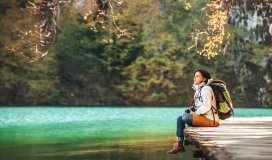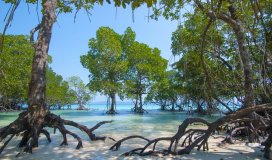Experience Best of East India – Part 2
Table of Contents
 Underexplored and underappreciated, India’s north-eastern states are full of surprises. Here is the list of places to visit in the north-eastern part of India. If you”ve missed out the list of places mentioned in the part-1, not to worry. Check now!
Underexplored and underappreciated, India’s north-eastern states are full of surprises. Here is the list of places to visit in the north-eastern part of India. If you”ve missed out the list of places mentioned in the part-1, not to worry. Check now!
1. Caves in Khasi, Garo and Jaintia Hills

This north-eastern state is known for its 1,000+ mysterious and wonderful caves, each different from the other. These geological wonders have fascinated speleologists and tourists alike. Check out the massive stalagmite, resembling a Shivalingam, in the Mawsynram cave. The Krem Dam is the largest cave in all of India, formed entirely out of sandstone in stunning hues. The tranquil and elegant Krem Kotsati can only be accessed by rubber dinghy. There is lots still unknown in Meghalaya. You can choose Meghalaya as the next travel destination as it still have lots unravelled and yet to be explored.
2. Jaintia Hills

Home to the indigenous Jaintia tribe, this set of mountains underscores Meghalaya’s stunning natural beauty. Deep forests, lush meadows, twinkling lakes, waterfalls that become rushing rivers, this is where the locals go to escape the city crush. Have a picnic on the banks of the Myntdu River, go boating on the Thadlaskein Lake, or check out the caves of Syndai. Head to the picturesque village of Jowai, which serves as the headquarters for the Jaintia tribe.
3. Nokrek Peak and Nokrek National Park

The climb up to Nokrek Peak (1,412m) is a must, if only to appreciate the unique biosphere of this remote north-eastern state. A trek through the Nokrek National Park is an experience to remember. Tall, dense forests, pristine unspoiled air, wild orchids, rare fruits and rarer species of birds, not to mention the occasional wild elephant: this is a treat for the senses. Look out for the ‘Memang Narang’, an indigenous citrus fruit believed to be parent of all citrus fruits. Check into any of the Tura Hotels. Wake up, freshen up and then head for the most awaited trek. This will help you get the best of the trip.
4. Balpakram Wildlife Park

With so much natural beauty and a state government that cares, wildlife parks are bound to spring up. Balpakram is where you go to see wild bison and elephants, and a cornucopia of rare medicinal plants and herbs that are watered copiously by several winding rivers and lakes. Check out Chidmak, the mysterious black water pool that is believed to be a repository of pious souls. You get a magnificent view of the Bangladeshi plains from the Balpakram plateau.
5. Namdapha National Park

This national park is home to three of the greatest endangered cats on the planet: the tiger, the snow leopard and the clouded leopard, apart from the rare Asiatic Golden cat and the marbled cat. Macaques of all shape and size swing through the trees, and you may just chance upon a Slow Loris or the extremely endangered Hoolock Gibbon. Four hundred and twenty five species of birds and 222 species of butterflies add colour to the air and foliage; that’s too many reasons to not miss this park.
6. Kameng River

The Kameng has earned a reputation of being one of the most challenging white-water experiences; only the experienced folk should try this out. But if you do take this up, it will be a trip you will never forget. The views of lush rainforests and distant snow-capped peaks, coupled with the roar of the river make for a truly overwhelming experience.
7. Tawang Monastery

This is the seat of Arunachal Pradesh’s religion and spirituality, a monastery precariously perched on the edge of a drop-off 3,500m above sea-level. It resembles a fort more than a place of worship. The monastery was designed to house 700 monks and has about 500 in residence at most times of the year. It is one-of-a-kind in all of India, and the largest in all of Asia, a continent known for its monasteries. The view from the top of the Tawang-Chu valley is too breath-taking to miss. Surf the list of hotels in Tawang Monastery Gompa Road. Pick a comfortable stay for a good travel experience.
8. Hornbill Festival

Every December, all of Nagaland’s 16-odd tribes gather to showcase their stunningly distinct diversity through song, dance and folklore. Dedicated to the Hornbill, a bird revered for its intelligence and grandeur, the festival is an astounding riot of sound and colour. Each tribe sports its own wildly flamboyant traditional dress, with spears adorned in dyed goat’s hair, and headgear woven out of bamboo, orchids and boar’s teeth. This festival is a huge hit with visiting foreigners and locals alike.
9. Cycling trails of Nagaland

This could well be an entire trip by itself, but you can also weave this into your north-east itinerary. Start from Dimapur and wind your way up nearly 1,400m into the misty hills of Kohima over gradual gradients, past evergreen forests, verdant valleys and vast farmlands. You will pass several indigenous village-tribes of Sangtam, Lotha, Ao and Angami, each friendly and hospitable and replete with vibrant culture. Intrepid tourists from all over the world consider this the best way to see Nagaland.
10. Dzoukou Valley and Japfu Peak

Be sure to do this trek, in its nine-day entirety, or just parts of it. Dzukou Valley, aka ‘Valley of Flowers’, at a height of 2,400m, is aptly named. From October to March, the valley comes alive with multi-coloured, fragrant white and red rhododendron, lilies and several other wildflowers. Japfu Peak, at 3,014m, is Nagaland’s highest peak and boasts a 109-ft rhododendron tree that has made it to the Guinness World Records. The trek is rated moderate-difficult, and is hugely popular with tourists.
11. Ima Keithel (Mother’s Market)

This 4,000-stall strong Mother’s (Ima) Market has the distinction of being the world’s only market run exclusively by women, a testimony to the power and status of women-folk in this tiny north-eastern state. You will find everything from dried fish and fresh veggies and fruits to ethnic handlooms. This is more than just a marketplace; it is a hub where social and political issues are discussed and argued, and it is said that the women’s uprisings of 1904 and 1939 against the British had their geneses here.
12. Keibul Lamjao National Park

This is the only floating sanctuary in the world. It sprawls over 40 sq km of floating vegetation and India’s largest freshwater body, the Loktak Lake. It is home and last refuge to the delightful dancing deer, the Sangai, a critically endangered species that now thrives here. The shy and rare clouded leopard and the marbled cat can sometimes be spotted at the south end of the park, close to the Indo-Burma border. Elephants roam in scattered herds. This park is a must-see for its biodiversity.
Insider Tip:
To visit Arunachal Pradesh, Mizoram and Nagaland, you need to obtain an inner line permit. Get the details here.



